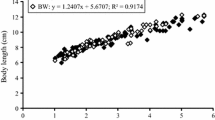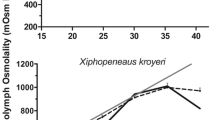Abstract
Crabs can actively uptake or extract ions to adapt to their diverse habitats. The gills are the main osmoregulatory organ in crabs, and Na+/K+-ATPase (NKA) pump is one of the main enzymes involved in the osmoregulatory process. Three crab species from three different habitats, including Portunus armatus (marine spicies), Macrophthalmus dentipes (estuarial species) and Eriocheir hepuensis (freshwater species) were used in the present study. The aim of the present study was to investigate the distribution and activity of NKA pump in the posterior gill of these species. In this regard, the tissue structure of the posterior gill, Immunolocalization and activity of the NKA pump in the posterior gill were assessed in three selected species. The levels of electrolytes (including Na+, Cl−, K+, Ca2+, Mg2+) in the posterior gill, hemolymph and water of different habitats were also measured. In addition, the osmolality of crab species compared to the water of their habitats was investigated. Based on the results, the gill tissue structure was similar in the studied species. However, the highest and lowest intensity of immunofluorescence staining and the activity of NKA pump were recorded in estuarial and freshwater species, respectively. The osmolality of hemolymph in P. armatus was isosmotic with seawater, whereas, the hemolymph of M. dentipes and E. hepuensis was in hyperosmotic state with ambient water. It can be concluded that, Na+/K+-ATPase plays a more important role in the estuary and seawater adaptation of crabs. On the other hand, Freshwater species are not highly dependent on this enzyme for osmoregulation.













Similar content being viewed by others
References
Anger K, Charmantier G (2000) Ontogeny of osmoregulation and salinity tolerance in a mangrove crab, Sesarma curacaoense (Decapoda, Grapsidae). J Exp Mar Biol Ecol 251:265–274. https://doi.org/10.1016/s0022-0981(00)00223-9
Charmantier G, Charmantier-Daures M, Towle D (2009) Osmotic and ionic regulation in aquatic arthropods. In: Evans DH (ed) Osmotic and ionic regulation cells and animals. CRC Press, Boca Raton, pp 165–230
Cieluch U, Anger K, Aujoulat F, Buchholz F, Charmantier-Daures M, Charmantier G (2004) Ontogeny of osmoregulatory structures and functions in the green crab Carcinus maenas (Crustacea, Decapoda). J Exp Biol 207:325–336. https://doi.org/10.1242/jeb.00759
Farias DL, Lucena MN, Garcon DP, Mantelatto FL, McNamara JC, Leone FA (2017) A kinetic characterization of the gill (Na+, K+)-ATPase from the semi-terrestrial Mangrove Crab Cardisoma guanhumi Latreille, 1825 (Decapoda, Brachyura). Memb Biol 250:517–534. https://doi.org/10.1007/s00232-017-9978-6
Freire CA, Onken H, McNamara JC (2008) A structure–function analysis of ion transport in crustacean gills and excretory organs. Comp Biochem Physiol 151A:272–304. https://doi.org/10.1016/j.cbpa.2007.05.008
Genovese G, Ortiz N, Urcola MR, Luquet CM (2005) Possible role of carbonic anhydrase, V-HATPase, and Cl–/HCO3–exchanger in electrogenic ion transport across the gills of the euryhaline crab Chasmagnathus granulatus. Comp Biochem Physiol 142A:362–369. https://doi.org/10.1016/j.cbpa.2005.08.024
Henry RP (1995) Nitrogen metabolism and excretion for cell volume regulation. In: Walsh PJ, Wright P (eds) Nitrogen metabolism and excretion. CRC Press, Boca Raton, pp 63–74
Henry RP, Lucu C, Onken H, Weihrauch D (2012) Multiple functions of the crustacean gill: osmotic/ionic regulation, acid-base balance, ammonia excretion, and bioaccumulation of toxic metals. Front Physiol 3:431. https://doi.org/10.3389/fphys.2012.00431
Holdich DM (2002) Biology of freshwater crayfish. Blackwell Science, London, p 720
Kone BC, Takeyasu K, Fambrough DM (1991) Structure-function studies of the Na/K-ATPase isozymes. In: Kaplan JH, Deweer P (eds) The sodium pump: recent development. Rockefeller University Press, New York, pp 265–269
Little C (1990) The terrestrial invasion: an ecophysiological approach to the origins of land animals. Cambridge University Press, Cambridge, p 316
Lowry OH, Rosebrough N, Farr A, Rundall R (1951) Protein measurement with folin phenol reagent. J Biol Chem 193(3):265–275
Lucu C, Towle DW (2003) Na+K+ATPase in gills of aquatic crustacean. Comp Biochem Physiol 135A:195–214. https://doi.org/10.1016/S1095-6433(03)00064-3
McNamara JC, Faria SC (2012) Evolution of osmoregulatory patterns and gill ion transport mechanisms in the decapod Crustacea: a review. J Comp Physiol 182B:997–1014. https://doi.org/10.1007/s00360-012-0665-8
Morris S (2001) Neuroendocrine regulation of osmoregulation and the evolution of air-breathing decapod crustaceans. J Exp Biol 204:979–989
Ng PKL, Guinot D, Davie PJ (2008) Systema Brachyurorum: Part I. An annotated checklist of extant brachyuran crabs of the world. Raff Bull Zool 17:1–286
Onken H, McNamara JC (2002) Hyperosmoregulation in the red freshwater crab Dilocarcinus pagei (Brachyura, Trichodactylidae): structural and functional asymmetries of the posterior gills. J Exp Biol 205:167–175
Pequeux A (1995) Osmotic regulation in crustaceans. J Crust Biol 15:1–60. https://doi.org/10.1163/193724095X00578
Pierce SK (1982) Invertebrate cell volume control mechanisms: a coordinated use of intracellular amino acids and inorganic ions as osmotic solute. Biol Bull 163:405–419
Pierce SK, Amende LM (1981) Control mechanism of amino acid-mediated cell volume regulation insalinity-stressed molluscs. J Exp Zool 215:247–258
Putzenlechner M, Graszynski K (1995) Regulation of the V-type proton pump in the gills of the Chinese crab Eriocheir sinensis. Verh Dt Zool Ges 88:124
Rainbow PS, Black WH (2001) Effects of changes in salinity on the apparent water permeability of three crab species: Carcinus maenas, Eriocheir sinensis and Necroa puber. J Exp Mar Biol Ecol 264:1–13. https://doi.org/10.1016/S0022-0981(01)00289-1
Romano N, Zeng C (2006) The effects of salinity on the survival, growth and haemolymph osmolality of early juvenile blue swimmer crabs, Portunus pelagicus. Aquaculture 260:151–162
Strange K (1994) Cellular and molecular physiology of cell, vol regulation. CRC Press, Boca Raton, p 416
Towle DW, Paulsen RS, Weihrauch D, Kordylewski M, Salvador C, Lignot JH (2001) Na++K+-ATPase in the gills of the blue crab, Callinectes sapidus: cDNA sequencing and salinity-related expression of α-subunit mRNA and protein. J Exp Biol 204:4005–4012. https://doi.org/10.1242/jeb.204.22.4005
Tsai J, Lin H (2007) V-type H+-ATPase and Na+, K+-ATPase in the gills of 13 euryhaline crabs during salinity acclimation. J Exp Biol 210:620–627. https://doi.org/10.1242/jeb.02684
Weihrauch D, Ziegler A, Siebers D, Towle DW (2001) Molecular characterization of V-type H(+)-ATPase (B-subunit) in gills of eury-haline crabs and its physiological role in osmoregulatory ion uptake. J Exp Biol 204:25–37
Weihrauch D, Morris S, Towle DW (2004) Ammonia excretion in aquatic and terrestrial crabs. J Exp Biol 207:4491–4504. https://doi.org/10.1242/jeb.01308
Wieczorek H, Brown D, Grinstein S, Ehrenfeld J, Harvey WR (1999) Animal plasma membrane energization by proton-motive V-ATPases. BioEssays 21:637–648. https://doi.org/10.1002/(SICI)1521-1878(199908)21:8%3c637::AID-BIES3%3e3.0.CO;2-W
Acknowledgements
This work was practically supported by the Khorramshahr University of Marine Science and Technology.
Author information
Authors and Affiliations
Corresponding author
Additional information
Publisher's Note
Springer Nature remains neutral with regard to jurisdictional claims in published maps and institutional affiliations.
Rights and permissions
About this article
Cite this article
Khalifi, K., Salamat, N. & Movahedinia, A. Osmotic Regulation Strategy in Three Marine, Estuarial and Freshwater Crab Species (Portunus armatus, Macrophthalmus dentipes and Eriocheir hupensis). Ocean Sci. J. 57, 104–117 (2022). https://doi.org/10.1007/s12601-021-00051-x
Received:
Revised:
Accepted:
Published:
Issue Date:
DOI: https://doi.org/10.1007/s12601-021-00051-x




